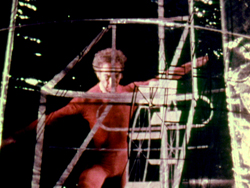Description
Walkaround Time (1973) marks Charles Atlas' first visual documentation of a Merce Cunningham dance. Soon after the film's creation, the choreographer approached Atlas, who was then the dance company's assistant stage manager, to collaborate with him through video. Unlike many of their collaborative video works, in which Cunningham composed dances specifically for the camera, Walkaround Time (1968) was originally created as a stage dance. The dance depicted in Walkaround Time is thus not geared towards the camera's eye but towards the space-time of the stage.
The set of Walkaround Time consists of seven large translucent inflatables screen-printed with images taken from Marcel Duchamp's The Bride Stripped Bare by Her Bachelors, Even (1915-1923), commonly referred to as The Large Glass. Artist Jasper Johns, who had been Cunningham's artistic adviser since 1966, proposed the set idea to Cage, Cunningham and Duchamp during an after-dinner conversation.
States Charles Atlas: "Though the choreography, music and decor were each independently conceived, they shared a common thematic purpose: an homage to the work of Marcel Duchamp. Cunningham has translated Duchamp's concern with transparency in terms of a dance which explores the possibilities of lateral movement across a proscenium space. Cunningham's ready-made is the 'laissez-faire' movement during the 'entr'acte', and when he changes costume on stage it is a nod to the famous nude."
Elements of Cunningham's choreography for Walkaround Time further articulate the work as a Duchampian homage. Themes of repetition, the everyday and readymade pervade Cunningham's ballet and also connect to his interest in technological development and video. Archivist David Vaughn cites Cunningham discussing Walkaround Time's choreographic references to Duchamp: "I put in a lot of things about Duchamp and his work which I never tell anybody because this confuses people. Like readymades, for instance, because a readymade is something that is already done, and you can re-use it. So the piece has things that appear, not often, but over again..."
Through the repetition of dance phrases Cunningham creates a readymade lexicon from which the dancer's body pulls. For example, Cunningham, who dances in this work, mechanically jogs in place at several points during the performance. In addition to this Duchampian repetition, the choreographer's interest in everyday movement connects to the readymade concept. An intermission for the dancers becomes part of the dance, as the audience watches them stretch, change and rearrange the set. David Behrman's score for the dance, "...for nearly an hour...," makes use of found sounds such as gravel, cars and female voices discussing The Large Glass, expanding the readymade past objecthood to encompass sound and movement.
Despite famously claiming to have given up art for chess in 1923, Duchamp maintained a careful influence on younger artists in the 1960s. Most of Duchamp's activity after 1923 centered on repetition, in works such as La Boîte-en-valise (1935-1968). The Boîte continually reproduced a miniaturized set of his earlier works for over thirty years, completing 324 serializations and enclosing the replications in suitcases. Johns' replica of The Large Glass places Walkaround Time directly in dialogue with this project, creating a life-size experience of Duchamp's last "official" artwork and yet another copy to add to his reproductive oeuvre.
Dance professor and theorist Mark Franko notes that the concept of "dance as readymade" underpins video dance through its ability to replay and in turn unsettle the traditional notion of the "dance work." Franko connects Cunningham's early incorporation of pedestrian movement to his later use of video and choreographic computer programs in works such as Biped (1998). In his 1968 experimental book Changes: Notes on Choreography, the choreographer describes how Walkaround Time's title is a reference to "computer language." "You feed the computer information then you have to wait while it digests. There's some arguments as to whether the computer is walking around or those who are waiting." In a certain sense, Walkaround Time marks the transition between Cunningham's pedestrian movement and his later technological experiments, including his video collaborations with Atlas.
Choreography: Merce Cunningham. Directed by Charles Atlas. Music and Soundtrack: David Behrman, "...for nearly an hour..." Decor supervised by Jasper Johns after Marcel Duchamp's "The Large Glass." Dancers: Carolyn Brown, Merce Cunningham, Ulysses Dove, Douglas Dunn, Meg Harper, Susana Hayman-Chaffey, Chris Komar, Sandra Neels, Chase Robinson, Valda Setterfield
Exhibition & Distribution Conditions
This is a High-Definition video transfer of a work initially shot on film. This is best shown as a projection, to reflect the original medium.
High-Definition Video Guide
